
The Engine
It's a 2.4 liter straight-6 with an overhead cam and two valves per cylinder, fed with a pair of side draft SU carbs. Nissan claimed 150 horsepower but that's measured at the flywheel. At the wheels it was definitely less, typically around 120 hp. I'll get it dyno'd to know for certain.
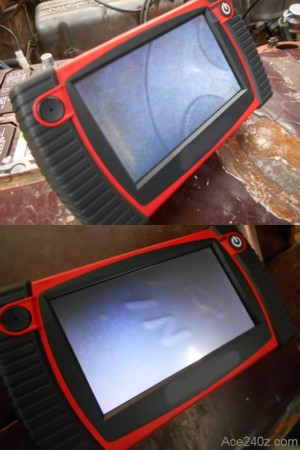 The previous owner said the engine had been rebuilt "fairly recently." A friend has a borescope camera so we poked it down thru the sparkplug holes to take a look. The top photo shows two valves that appear clean without any carbon buildup. The crosshatched hone patterns on the cylinder walls were still visible. The bottom photo is a piston with the manufacturer's part number clearly showing.
The guy didn't lie. It was indeed rebuilt, but done so badly that puffs of smoke came out the exhaust when I pulled away from a stop. I yanked it and took it to a local shop. When they took it apart, they found the cylinders were ever-so-slightly oval shaped, which meant the rings would never seat. The pistons had scuff marks from hitting the walls. One of the valve guide literally dropped out. The "rebuilt" engine was junk.
Oddly, before I discoved the damage, the car was put on a dyno and actually made good horsepower, putting out a generous 137 hp at 5400 rpm and 144 ft-lbs of torque. According to the dyno owner, when corrected for altitude (one mile above sea level) it would be about 150 hp. That's far more than stock. The cam appears to be an aftermarket version, but no idea who made it or what the specs are. The race-grade header also contributed to the performaance.
These engines are pretty robust if rebuilt correctly and good for well over 100k miles. Mine was scrapped.
I bought a barely-used L26 (2600cc) block and had it assembled with the cam, a new lightly-milled head and the intake manifolds were port-matched. I also added a 123ignition programmable distributor. I haven't taken it to the dyno at this point (July 2023) but based on the way it feels on the street, I've definitely gained some horsepower.
The previous owner said the engine had been rebuilt "fairly recently." A friend has a borescope camera so we poked it down thru the sparkplug holes to take a look. The top photo shows two valves that appear clean without any carbon buildup. The crosshatched hone patterns on the cylinder walls were still visible. The bottom photo is a piston with the manufacturer's part number clearly showing.
The guy didn't lie. It was indeed rebuilt, but done so badly that puffs of smoke came out the exhaust when I pulled away from a stop. I yanked it and took it to a local shop. When they took it apart, they found the cylinders were ever-so-slightly oval shaped, which meant the rings would never seat. The pistons had scuff marks from hitting the walls. One of the valve guide literally dropped out. The "rebuilt" engine was junk.
Oddly, before I discoved the damage, the car was put on a dyno and actually made good horsepower, putting out a generous 137 hp at 5400 rpm and 144 ft-lbs of torque. According to the dyno owner, when corrected for altitude (one mile above sea level) it would be about 150 hp. That's far more than stock. The cam appears to be an aftermarket version, but no idea who made it or what the specs are. The race-grade header also contributed to the performaance.
These engines are pretty robust if rebuilt correctly and good for well over 100k miles. Mine was scrapped.
I bought a barely-used L26 (2600cc) block and had it assembled with the cam, a new lightly-milled head and the intake manifolds were port-matched. I also added a 123ignition programmable distributor. I haven't taken it to the dyno at this point (July 2023) but based on the way it feels on the street, I've definitely gained some horsepower.
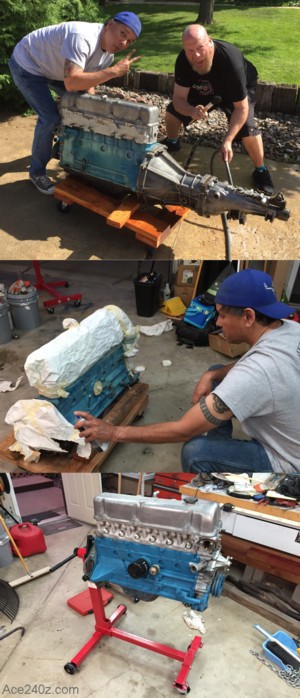 My friends Mac and Adolpho volunteered to clean and paint the engine. Naturally I said yes. The block was soaked with a degreaser, then attacked with steel brushes, then soaked again and the scrubbing repeated. It worked pretty well.
Online I found the "correct" factory shade of blue at the ludicrous price of $65 per can. I opted for a similar blue at just $8. With can in hand, Adolpho demonstrated the painting skills he learned while tagging in his youth. Mac stood back and drank beer and offered advice. I gave the valve cover a nice polish, then called it a day.
The engine is now all bright and fresh and ready to go. Too bad it turned out to be worthless.
My friends Mac and Adolpho volunteered to clean and paint the engine. Naturally I said yes. The block was soaked with a degreaser, then attacked with steel brushes, then soaked again and the scrubbing repeated. It worked pretty well.
Online I found the "correct" factory shade of blue at the ludicrous price of $65 per can. I opted for a similar blue at just $8. With can in hand, Adolpho demonstrated the painting skills he learned while tagging in his youth. Mac stood back and drank beer and offered advice. I gave the valve cover a nice polish, then called it a day.
The engine is now all bright and fresh and ready to go. Too bad it turned out to be worthless.
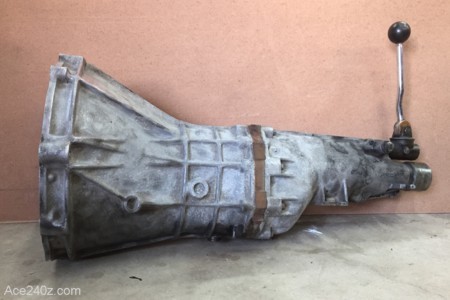 I did some searching and found a 5-speed transmission. It turned out to be an FS5C71B which is a "competition" gearbox with tighter gear ratios, a Porsche-type synchromesh, and rated for 250 ft/lb of torque. I replaced the front and rear seals, filled it with fluid, and I'm keeping my fingers crossed that it doesn't need to be rebuilt.
Just in case, I kept the orginal 4-speed.
I did some searching and found a 5-speed transmission. It turned out to be an FS5C71B which is a "competition" gearbox with tighter gear ratios, a Porsche-type synchromesh, and rated for 250 ft/lb of torque. I replaced the front and rear seals, filled it with fluid, and I'm keeping my fingers crossed that it doesn't need to be rebuilt.
Just in case, I kept the orginal 4-speed.
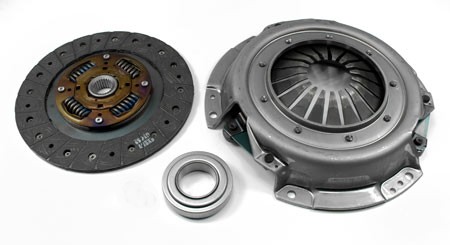 While the engine was out, I replaced the clutch, which means the flywheel needs to be removed and resurfaced.
The 5-speed transmission came with the release bearing and the collar that attaches to the throw-out arm. My original transmission also came with a collar but it turns out the collars come in several different heights. Even though I used a stock replacement clutch I needed to measure how far it sticks into the bell housing in order to know which collar to use. The wrong collar means the clutch won't work. Click here to determine which one you need.
A lighter flywheel allows the engine to rev more quickly. Like with the collars, flywheels come in different weights, the heaviest of which is 23 pounds. Some people use flywheels as light as 10-11 pounds, which is great for racing but can be difficult for street use. 16-17 is supposed to be a good compromise. If you want a lighter flywheel you have the option of letting a machine shop shave some of the metal off your existing one, or you can buy an aluminum version, but they're not cheap. I snuck mine into a grocery store and used one of their produce scales to weigh it. Turns out it's 19.5 pounds, which is fine.
A final note: the genuine Nissan clutch is pretty robust. I know that because the clutch in my previous Z never failed despite a lot of abuse.
While the engine was out, I replaced the clutch, which means the flywheel needs to be removed and resurfaced.
The 5-speed transmission came with the release bearing and the collar that attaches to the throw-out arm. My original transmission also came with a collar but it turns out the collars come in several different heights. Even though I used a stock replacement clutch I needed to measure how far it sticks into the bell housing in order to know which collar to use. The wrong collar means the clutch won't work. Click here to determine which one you need.
A lighter flywheel allows the engine to rev more quickly. Like with the collars, flywheels come in different weights, the heaviest of which is 23 pounds. Some people use flywheels as light as 10-11 pounds, which is great for racing but can be difficult for street use. 16-17 is supposed to be a good compromise. If you want a lighter flywheel you have the option of letting a machine shop shave some of the metal off your existing one, or you can buy an aluminum version, but they're not cheap. I snuck mine into a grocery store and used one of their produce scales to weigh it. Turns out it's 19.5 pounds, which is fine.
A final note: the genuine Nissan clutch is pretty robust. I know that because the clutch in my previous Z never failed despite a lot of abuse. 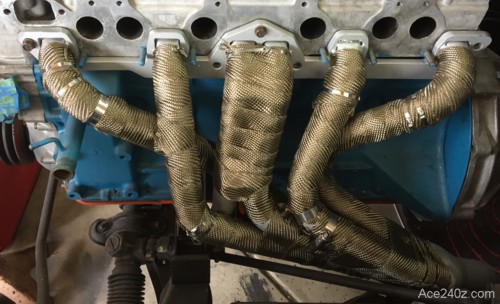 The header got wrapped with heat tape. It's not difficult - it just requires some time and patience.
If you look online you can find a bit of disagreement on how it should be done. Some say you need to paint the header first, while others say never paint it. Some say you need to soak the tape in water before wrapping it. A few people claim heat tape is a waste of time and money.
Whether or not it increases performance, or keeps the engine bay cooler isn't really an issue because I like the way it looks. Unfortunately, once the intake manifold and carbs and air filter are installed, most of it won't be seen.
The header got wrapped with heat tape. It's not difficult - it just requires some time and patience.
If you look online you can find a bit of disagreement on how it should be done. Some say you need to paint the header first, while others say never paint it. Some say you need to soak the tape in water before wrapping it. A few people claim heat tape is a waste of time and money.
Whether or not it increases performance, or keeps the engine bay cooler isn't really an issue because I like the way it looks. Unfortunately, once the intake manifold and carbs and air filter are installed, most of it won't be seen.
I also rebuilt the carbs (sorry, no photo) which is easy enough but afterward they need to be adjusted and synchronized. You can find synchronizers online and they're relatively inexpensive. It takes a little fiddling but essential for a good-running engine. As I mentioned at that top, I'm going to have the engine dyno'd and I'll let a professional do the synchonizing.